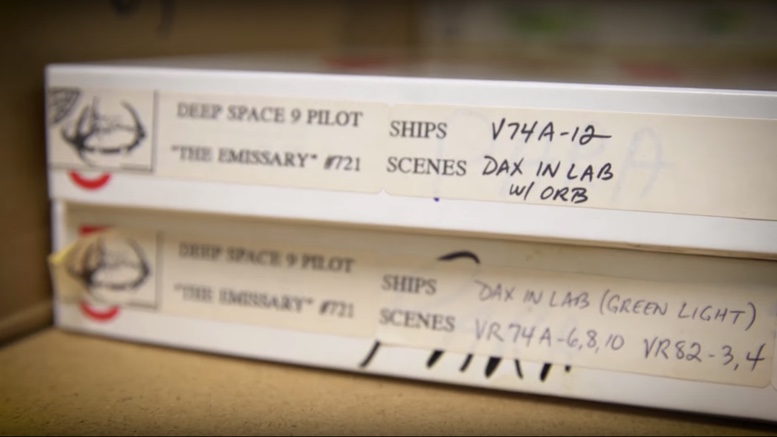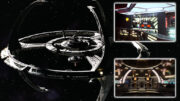The team from the Star Trek: Deep Space Nine documentary What We Left Behind shared a status update this afternoon which included a video update from producer Ira Steven Behr.
As we previously reported, the actual interviews, editing, sound mix, and most of the other elements have been completed. The documentary had early backer premiere events late last year, but the clips from DS9 seen at those events were a mix of newly scanned high definition and older standard definition footage.
Thanks to an outpouring of support from fans, the documentary team set about upgrading all clips from the show. In today’s video, Ira gives fans an update on the remastering progress.
Remastering episode footage
The documentary has over 20 minutes of footage from DS9 spanning all seven seasons, which involves scanning 400 reels of 35mm film. The original film reels have to be located, brought out of storage, scanned, and then color corrected and generally cleaned up of any blemishes. It’s not a trivial task. Today’s official DS9 Doc update notes:
We’re nearly through the heavy research-and-scanning stage of our remaster, and with just a few (hundred) more film rolls ahead of us, we’re hard at work replacing the 20+ minutes of new HD sequences — spanning ALL SEVEN seasons of the original run of Deep Space Nine!
What about a release date?
The team knows we’re all clamoring for a final version. But they’re not quite ready to give a date yet. Again from the update:
The restoration process alone is a HUGE undertaking — after all your support in funding this expensive endeavor, it has taken months of work from the CBS Digital team to coordinate, research, find, ship, scan and deliver the original film negatives for us, and more time from our team to clean up, color, and polish the resulting images (and even re-create a handful of effects!).
While we’re still waiting on final elements to arrive and distribution details to lock firmly into place, we don’t want to promise any deadlines we can’t meet with the film not yet entirely complete.
More coming soon
The end of their update teases something big coming later in March.
We’ve got BIG news in the works and expect you’ll be hearing much more from us later this month.
You can show your support and pre-order the final release at www.ds9documentary.com
Keep up with all the updates and news on the DS9 documentary in our What We Left Behind category here at TrekMovie.com






Big news? DS9 in HD?
“Big news” would be in the context of news about the documentary.
The documentary has no control over what CBS does with remastering the series. They’re small fish, paying a ton of money to remaster selected clips. CBS makes the call to remaster the series, and would be the one to announce it. They made the decision long ago to not continue on to remaster DS9 after TNG. It’s a massive undertaking taking many thousands of man hours to reassemble the episodes, and create new CG effects, etc.
There will be a day coming where you will see DS9 in HD.
I’ll buy now if I could!
Remastering DS9 in HD as a streaming exclusive for CBS All Access, perhaps?
Gosh I hope so!!
This film is so late. You guys missed the anniversary! I’ll never help pay for something like this again. It’s been a very disappointing experience for me.
I’ll bet good money you’ll change your mind when you see the final product….
I’m all the more happy to wait for this. I know the longer they work the more polished the end product will be.
See my response to Thomas W. further down. Same applies here.
You are obviously new to this sort of thing. When Starship Exeter put its first few minutes on the ‘net, I eagerly ponied up a donation. That was in 2004. The final finished product wasn’t released until 2014. One of the release channels, YouTube, didn’t even exist in 2004.
It was also, by the way, TOTALLY worth the wait. The brothers behind Exeter never compromised their vision rushing out an inferior film, and the results speak for themselves—to this day it’s still one of the best semi-pro Star Trek productions.
I’m also a donor to the documentary, and I would rather wait and get something that will stand the test of time. Plus, I really, REALLY want to see what DS9 would have looked like in high definition. Be patient. It will get here when it’s ready, and it will be magnificent.
True, it’s a bit late, but 2019 marks exactly 20 years since “What You Leave Behind” aired, so it’s kind of fitting to release “What We Left Behind” this year. I’m sure the end result will have been worth the wait.
Is it more important to be done on time or be done correctly?
Seems as if you didn’t understand the risks of crowdfunding projects.
dude… pay some respect to hard working people. They still do it for you!
How much did you donate, somehow I am guessing your at the lower end of the donation amount . And stomping your feet and saying I won’t play again in the future, because your not happy with the amount of time to takes to make a quality product says a lot. It’s not like they are dragging their feet, they provide regular updates, they even managed a rough cut screening for the people who donated the amount required for the screening before the end of last year.
Behr is starting to turn this project into his own version of Avatar lol. I’m sure it will be worth it though but we are still talking just HD clips. Its not something people are going to pop in years from now just to watch a five minute scene but its nice to see how passionate he is about it. I imagine this is why DS9 came out so well.
I have no idea what they are doing. Only 20 Minutes of material to scan and correct and they are working on it for years.
Yes. You have no idea ;)
It’s not like yo sit down at your pc and scan a paper. If they have to paint out blemishes, that’s a time-intense process for sure. if they are to recreate certain special effects from scratch even more so.
I myself am working on a scifi short which is “only” 30 minutes long since 2015. It all comes down to resources and manpower.
Agree 100% with you there, German Trekkie. Good luck with your project :)
Thanks sir or mam :)
(…in addition, they have to literally beg for the money to continue the work)
You don’t have an idea. If you did you’d fully understand why this project is taking so long. It’s a labor of love and I and many other fans are more than happy to wait. For as long as it takes. It’s a big world out there, not everything revolves around ‘me’ and ‘I.’
It’s sort of like car racing. How fast you want to get to the finish depends on how much money you have to spend.
I worked on some of the TNG HD project years ago, and let me tell you, it’s not a quick and easy process. It takes a lot of effort by many hands to scan the and correct the footage, make sure you have the right takes, and then do what we call “dust busting.” That’s the process of going through frame by frame on each scene and painting out dust and hairs, whatever else that ends up in the footage. Sometimes, that’s a pretty easy process, other times, not so much. A lot of them show up as big white dots on the frame.
Thanks Matt, really appreciate someone who does this stuff for a living weighing in.
It sells much better to Netflix or Amazon with the HD clips than it would in SD. While it’s funded by the fans, I 100% guarantee that one of the reasons Behr & Co. started this process is that they think a DS9 documentary will sell well. (And I’m sure it will.) Altruism is wonderful stuff, but it doesn’t pay the bills.
sure because Behr & Co are such poor people with no money.
I have seen this movie last year in Birmingham. Some of the clips were in HD and some in SD. Believe me it’s worth the wait when all the clips will be in HD. The HD stuff they showed was the battles from season 6 and it was amazing.
I’m rewatching DS9 once a year on Netflix. I bet they would add a pretty penny to the remastering to HD. I would even accept a monthly fee to make it possible.
DS9 in HD would be a heck of a carrot for All Access to exclusively dangle. Bizarre they don’t have all of TNG in HD. Surely they’ve also at least pondered the idea of seeing if Netflix would subsidize the cost in exchange for an exclusive window with HD DS9 and Voyager.
Yeah, that would be awesome, plus a no-brainer.
I would have thought they would have scanned and restored the film in 4K in this day and age. Even if their release is for HD Blu-ray, it seems like minimal extra effort to clean a 4K scan and then they’d have it for a future release.
Has CBS Digital not upgraded their space to handle 4K as the default?
That’s not how things work. I’m sure CBS-D can handle 4K, but that’s not the determining factor.
The target for the documentary project is 1080p (effectively 2K) so they scan for that. Remember this is not something CBS is doing – this third party documentary is paying CBS Studios for the license to clips of DS9 and to handle the film assets and scanning via CBS Digital. The final output is for the documentary’s use, not CBS’ own use.
CBS Digital is simply executing a project for a client. If you’re not aware, CBS Digital does jobs for all sorts of productions in the industry, not just CBS itself. One of their most famous jobs is the title sequence for ABC’s Modern Family.
http://cbsdvfx.com/
4K requires a ton more storage and processing power to handle (8 million pixels a frame versus 2 million). 2K equipment and editing is ubiquitous and inexpensive comparatively. They work in whatever production pipeline is most appropriate given the budget, time, etc.
Also note that they are simply scanning in clips, not whole episodes. So while they may be pulling out a lot of reels of film, they almost certainly don’t add up to whole episodes. So, the limited scope of what they’re doing for the documentary does not really help CBS with a future hypothetical proper remaster.
Future 4K for the people making the documentary, not for CBS Digital exclusively.
You might be right that it doesn’t work that way, but it is just being short sighted on their part.
If someone comes to CBS Digital and asks for a 4K clip of DS9 to use as a promo somewhere, CBS would have to go through the entire process again instead of just pulling the digital copy.
I mean heck if I, as a freelance videographer, can afford to archive every project I’ve ever done to digital, surely CBS could afford the space to store all their assets to digital when the chance arises.
Of course I also think they should be finishing Star Trek Discovery in 4K too and they don’t appear to be.
Matt – maybe you’re the one who can finally answer.
Are 2k and 1080(x1920)p technically synonymous? Or just vaguely so? Shouldn’t we be missing about 80 (horizontal) pixels difference?
The Star Wars prequels I know were *actually* shot in 1080p. And “supposedly” they looked like “crap” on the big screen (and Clones did in fact appear soft and pixelated)… compared to (I would hope?) other movies out there that have a final post-production resolution of “2k.”
On the other hand, it’s hard to imagine 80 (times whatever) pixels would make that much difference.
Are 2k and 1080(x1920)p technically synonymous? Or just vaguely so?
They are roughly analogous but, no, they are not the same thing.
1080p is a 16:9 consumer format. The corresponding professional specification is 2K, but that’s a different standard with much higher quality storage requirements with far less compression and a much higher overall bitrate and per-pixel bit depth, a wider color space, and the standard has a pixel arrangement that allows for the various common cinematic aspect ratios within it.
https://en.wikipedia.org/wiki/Digital_Cinema_Initiatives#Image_and_audio_capability_overview
To make things confusing, consumer electronics vendors decided that saying “4K” was cooler than saying “Ultra HD,” so they started using “4K,” when again there’s a difference. Consumer UHD is basically quad HD, it’s still fixed at 16:9 and results in a slightly different resolution than the professional 4K standard. To say nothing of the major differences in quality as outlined above (though the UHD standard does help close the gap in some aspects).
Shouldn’t we be missing about 80 (horizontal) pixels difference?
That goes back to what I mention above, the professional specs allow for a variety of common cinema aspect ratios within their standard. The consumer formats (HD and UHD) are locked to 16:9, so the consumer format is not “missing” the pixels, rather, anything that’s not 16:9 is resized to fit (which is why some content gets black bars, either on the top or the sides depending on the shape), so the visual data is there, nothing is technically lost, it’s rescaled.
The Star Wars prequels I know were *actually* shot in 1080p. And “supposedly” they looked like “crap” on the big screen (and Clones did in fact appear soft and pixelated)… compared to (I would hope?) other movies out there that have a final post-production resolution of “2k.”
They do look quite poor IMO. Watching the prequels shot on those early HD cams, looks pretty poor on my decent UHD/4K TV from 2016. However that’s less about pixel counting, and more about the very early technology it used. The prequels also pre-date the DCI standard I linked above, so they were basically doing whatever they wanted.
Those early cameras were very “digital” looking and did not have the kind of advanced camera sensors we’ve come to expect from the best digital cinema cameras today. The output format (the tape based HDCAM format) was also rather low quality compared to what would develop just a few years later (full quality output directly to high capacity flash memory). What Lucas shot Episode II and III on would today be thought of as an inexpensive camera a local news van might carry. As an aside, Episode III looks quite a bit better than Episode II because by then a much improved second generation Sony camera was ready.
https://en.wikipedia.org/wiki/CineAlta#History_and_use_in_motion_pictures
Another reason why the prequels can look soft is that often they were rendering the VFX at anywhere from what could be described as 1K (which is not a standard) on up to the native 1080p of the HD camera footage.
“What Lucas shot Episode II and III on would today be thought of as an inexpensive camera a local news van might carry. Another reason why the prequels can look soft is that often they were rendering the VFX at anywhere from what could be described as 1K (which is not a standard) on up to the native 1080p of the HD camera footage.”
That is actually quite laughable. Thanks Matt for the lowdown.
I wouldn’t say it was laughable, especially for a movie that was shot in 2000 with the technology available at the time. It was state of the art at the time and an experiment on Lucas’ part since he was always about embracing the latest technology and pushing it to the limit. He took the first step, put his own money behind it and everyone else would eventually follow. I think often lost in the equation is just how groundbreaking much of the technology in that film was.
And Episode III was a significant leap over Episode II as they adjusted to working digitally. Episode II was a first step, Episode III started to get the hang of things and before long the transition to digital was in full force.
Production on Episode II wrapped in September of 2000 so we’re looking at a film that was shot in HD nearly 20 years ago .
Episode III started to get the hang of things and before long the transition to digital was in full force.
Yep. Episode III looks noticeably better.
And as you said the transition started in full force, 2005 (around the time of Episode III) is when the Digital Cinema specs got standardized. It’s amazing to see how far we’ve come.
I just don’t ever see this or any other series come to Blu-ray. TOS series sold well but Next Gen didn’t do so well and you can pick up TOS and Next Gen for a song and a pray now. Physical media is at a in pass.The mistake people make with any physical media is waiting until it goes on sale instead of buying it at release time. If you don’t buy it at release time it sends a message to the studios that were not interested in discs anymore and they will stop making DVD, Blu-ray and 4K blu-ray.That would include gaming discs.Streaming has picked up in the last few years. I don’t like it for a few reasons but never the less streaming is easy.Download and go or go to Netflix and your there. We become so lazy as a society we can’t even get up put a disc in the player and enjoy. Oppo and Samsung are now out of the blu-ray player business, no more players. I doubt when 8K TV’S comes to the stores there will be no disc players ,no disc content. A few years away but it’s coming. I love 4K however I think I got duped and this was the plan. 8K wasn’t ready so let’s give them 4K until 8K is ready . DS9 will never be on a blu-ray disc, maybe they will stream it. But no matter what they do the cost of getting the series for HD is to much money to produce. Last, the truth is Star Trek doesn’t sell well, never has except in the DVD days.
You know, I wonder if CBS might consider doing an HD DS9 for All Access/Netflix only? And release it in an episodic format( or half a season every 3-4 months) then release it physically. They did the episodic thing with the HD TOS on CBS back when it was first done. Second time’s the charm?
Deep Space Nine is the worst Star Trek show.
Not by a long shot and far too many episodes to counter that argument.
I’ve not bought any of the Trek shows but if DS9 got a HD remaster I would definitely pick it up.
Let’s hope the “big news” is Avery Brooks joining the film.
The documentary is done. They finished the actual documentary itself back in October 2018. The only thing they’re doing now is upgrading all the clips of DS9 in the documentary to HD.
Ira Behr has said repeatedly that Avery was consulted with frequently during the making of the documentary. His archival interviews and convention appearances have been used with his blessing, so it’s not like he’s absent from the documentary.